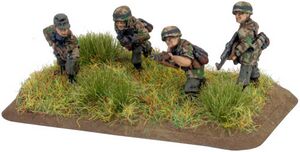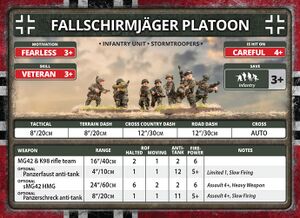Fallshirmjager Company

Fallschirmjäger Companies, aka Paratrooper companies, are a unit in Flames of War and a branch of the German Luftwaffe.
Early War[edit | edit source]

IRL[edit | edit source]

The Idea of Paratroopers was conceived quite early in the history of aviation. The Soviet Union tinkered with having elite paratroop units, but it was the Germans who more or less standardized the concept. Funnily enough, the Fallschirmjägers were actually classified as Luftwaffe assets, meaning that they were under Goering's whim during the conflict. The fat bastard really liked to cultivate his own personal power-base.
German Paratroopers earned a fierce reputation during the early war and played a valuable role in the Invasion of Poland, seizing valuable bridges and roads and awaiting the rest of the German army, in perfect unison with the German blitzkrieg tactics. They were used in France, Norway, and Operation Barbarossa but were used to disastrous effect at Crete, and were pretty much relegated to side duties post-Crete. It didn't help that Stalin was pretty much bulldozing straight towards Berlin with no brakes, and Paratroopers wouldn't do anything against dozens of tons of angry Commie cannon fodder and steel. Compounding this was that the allies had pretty much wrestled away German fighter superiority by this point, which would make the Junkers transport aircraft juicy targets for any unfortunate fool caught by a Spitfire, Mig, or Mustang looking to get back at ol' Adolf.
German Paratroops, much like Elysians, carried distinct weapons compared to general grunts. They carried MP40s on the jump with them, but most of their extra toys like rifles, crew-served MGs, and MG34s had to be dropped from the aircraft in containers. This was a severe liability, and this was specifically why the Battle of Crete went so terribly for them. So they decided to make the MG42, but with selective fire and lighter, and by accident made the most advanced weapon in the whole damn war: the FG42.
This weapon was something of a precursor to the later StG-44, in that it was designed with both automatic fire and precision single shots in mind, and had to be compact enough for paratroopers to carry. That being said, like most German technology, it was overcomplicated and difficult to manufacture; the weapon was required to be both Open Bolt-on full-auto and closed-bolt on semi-auto (which is an incredibly fussy system for limited benefit), the side-loading magazine gave it a very awkward balance, and the limited 20 round magazine didn't give it much capability for sustained fire.
| German Forces in Flames of War | |
|---|---|
| Tanks: | Panzer II - Panzer III - Panzer IV - Panther - Tiger - Tiger II - Panzer 38(t) - Captured Tank Platoon (Germany) |
| Transports: | SdKfz 250 - SdKfz 251 - Opel Blitzwagen |
| Infantry: | MG34 Platoon - AT-Rifle Team - Assault Pioneer Platoon - Grenadier Company - Fallshirmjager Company |
| Artillery: | PaK-40 Anti-Tank Gun - Hummel - Panzerwerfer 42 - Wespe - Grille - PaK-43 - 12cm Mortar - 8cm Mortar - 21cm Nebelwerfer 42 - 30cm Nebelwerfer 42 |
| Tank Destroyers and Assault guns: | Marder - StuG III - Jagdpanzer IV - Nashorn - Elefant - Jagdtiger - Brummbar - Hetzer - Sturmpanzer II Bison |
| Armored Cars: | SdKfz. 234/2 'Puma' - Sd.Kfz 222/223 - SdKfz. 231 |
| Aircraft: | JU-87 Stuka - HS-129 - ME-262 Sturmvogel |
| Anti-Aircraft: | Flak 88mm - Flakpanzer IV Wirbelwind & Ostwind |